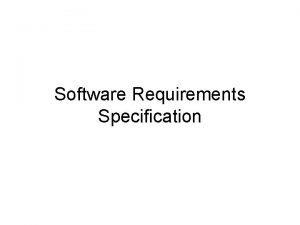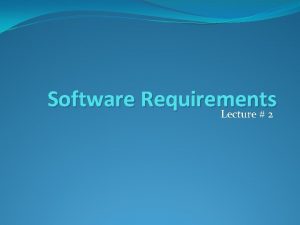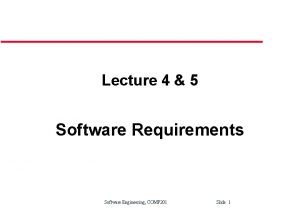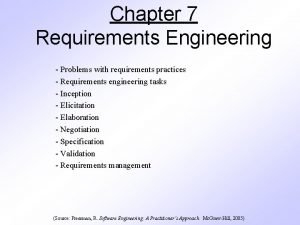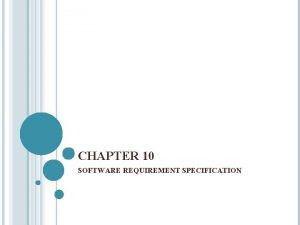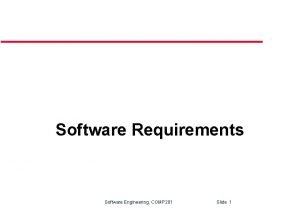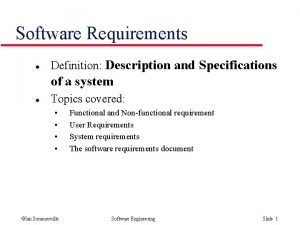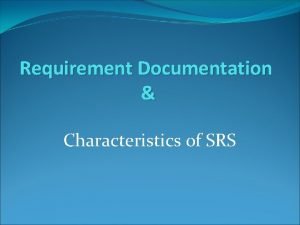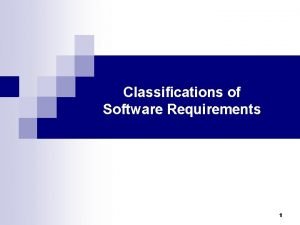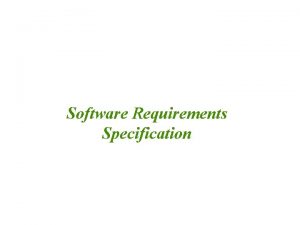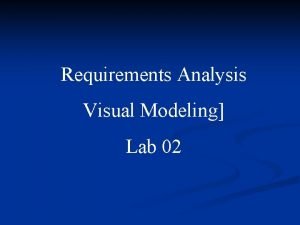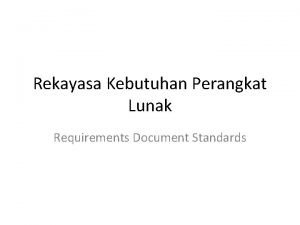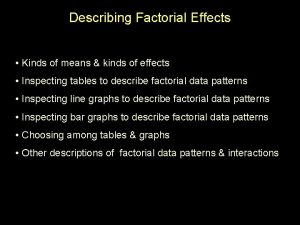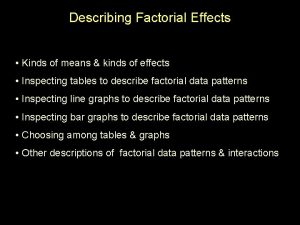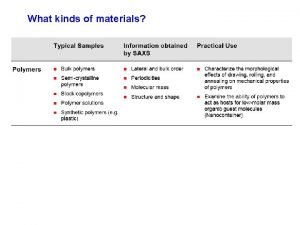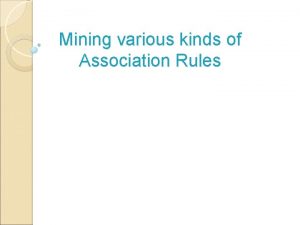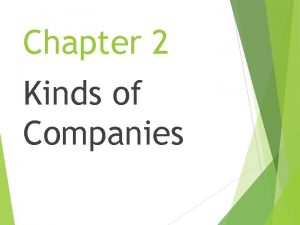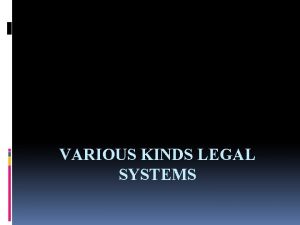Software Requirements Lecture 2 Kinds of Software Requirements
























- Slides: 24

Software Requirements Lecture # 2

Kinds of Software Requirements • • • Functional requirements Non-functional requirements Domain requirements Inverse requirements Design and implementation constraints 2

Non-Functional Requirements

Non-Functional Requirements - 1 • Most non-functional requirements relate to the system as a whole. They include constraints on timing, performance, reliability, security, maintainability, accuracy, the development process, standards, etc. 4

Non-Functional Requirements - 2 • They are often more critical than individual functional requirements • Capture the emergent behavior of the system, that is they relate to system as a whole 5

Non-Functional Requirements - 3 • Must be built into the framework of the software product • Failure to meet a non-functional system requirement may make the whole system unusable 6

Non-Functional Requirements - 4 • For example, if an aircraft system does not meet reliability requirements, it will not be certified as ‘safe’ • If a real-time control system fails to meet its performance requirements, the control functions will not operate correctly 7

Non-Functional Requirements - 5 • Non-functional requirements arise through user needs, because of budget constraints, because of organizational policies, because of the need of interoperability with other software and hardware systems, or because of external factors such as safety regulations, privacy legislation, etc. 8

Non-Functional Requirements Non-Functional requirements Product requirements Organizational requirements External requirements 9

Product Requirements Product requirements Usability requirements Performance requirements Efficiency requirements Reliability requirements Portability requirements Space requirements 10

Product Requirements Examples • The system shall allow one hundred thousand hits per minute on the website • The system shall not have down time of more than one second for continuous execution of one thousand hours 11

Organizational Requirements Organizational requirements Standards requirements Implementation requirements Delivery requirements 12

Organizational Requirements Examples • The system development process and deliverable documents shall conform to the MIL-STD-2167 A • Any development work sub-contracted by the development organization shall be carried out in accordance with Capability Maturity Model 13

External Requirements External requirements Interoperability requirements Ethical requirements Privacy requirements Legislative requirements Safety requirements 14

External Requirements Examples • The system shall not disclose any personal information about members of the library system to other members except system administrators • The system shall comply with the local and national laws regarding the use of software tools 15

Observations on Non-Functional Requirements - 1 • Non-functional requirements can be written to reflect general goals for the system. Examples include: – Ease of use – Recovery from failure – Rapid user response 16

Observations on Non-Functional Requirements - 2 • Goals are open to misinterpretation • Objective verification is difficult • Distinction between functional and non -functional is not always very clear 17

Observations on Non-Functional Requirements - 3 • Non-functional requirements should be written in a quantitative manner as much as possible, which is not always easy for customers • For some goals, there are no quantitative measures, e. g. , maintainability 18

Observations on Non-Functional Requirements - 4 • Goals can be useful to designers and developers, as they give clues to them about priorities of the customers 19

Observations on Non-Functional Requirements - 5 • Chances of conflicts within nonfunctional requirements are fairly high, because information is coming from different stakeholders. For example, different stakeholders can give different response times or failure tolerance levels, etc. 20

Observations on Non-Functional Requirements - 6 • Some negotiations must be done among different stakeholders, to achieve an agreement in these situations 21

Observations on Non-Functional Requirements - 7 • Non-functional requirements should be highlighted in the requirements document, so that they can be used to build the architecture of the software product 22

Summary • Discussed different aspects of the nonfunctional requirements • Non-functional requirements capture very important emergent behavior of the automated system • Due importance, time, and resources should be given to non-functional requirements 23

References • ‘Requirements Engineering: Processes and Techniques’ by G. Kotonya and I. Sommerville, John Wiley & Sons, 1998 • Software Requirements: Objects, Functions, and States by A. Davis, PH, 1993 • Software Engineering 6 th Edition, by I. Sommerville, 2000 • Software Engineering 5 th Edition, by R. Pressman 24
 01:640:244 lecture notes - lecture 15: plat, idah, farad
01:640:244 lecture notes - lecture 15: plat, idah, farad Software engineering lecture notes
Software engineering lecture notes 4 ps of project management
4 ps of project management Lecture presentation software
Lecture presentation software System requirements specification
System requirements specification Domain requirements
Domain requirements Inverse requirements example
Inverse requirements example Structured specification
Structured specification Requirements discovery techniques in software engineering
Requirements discovery techniques in software engineering Domain requirements in software engineering
Domain requirements in software engineering What is domain requirements
What is domain requirements External requirements in software engineering
External requirements in software engineering Problems of requirements in software engineering
Problems of requirements in software engineering Characteristics of srs in software engineering
Characteristics of srs in software engineering What are functional requirements in software engineering
What are functional requirements in software engineering What is domain requirements
What is domain requirements User characteristics in srs
User characteristics in srs Hardware and software requirements
Hardware and software requirements Source and sink analysis in software engineering
Source and sink analysis in software engineering Types of software requirements
Types of software requirements Applied software project management
Applied software project management Bad srs document
Bad srs document Visual models for software requirements
Visual models for software requirements Volere template
Volere template Kinds of wounds with pictures
Kinds of wounds with pictures




